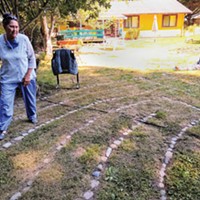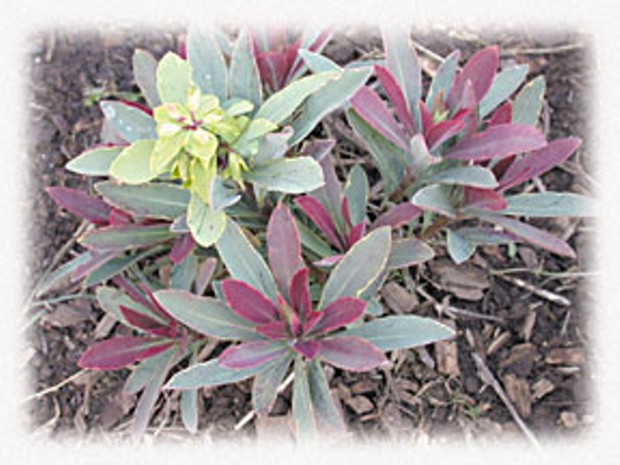[
{
"name": "Top Stories Video Pair",
"insertPoint": "7",
"component": "17087298",
"parentWrapperClass": "fdn-ads-inline-content-block",
"requiredCountToDisplay": "1"
}
]
This spring, a group of garden bloggers got the idea to post a photograph on the 15th of every month showing what's blooming in their garden. (If you'd like to check it out, just Google "garden bloggers bloom day" and you'll see what I mean.) It's a great idea to use a garden blog to keep track of what's blooming throughout the growing season, but what I really like about this project is that it gives me a chance to see how other people photograph their gardens. It's surprisingly difficult to get a good photograph of the garden. The light plays tricks with the camera, creating distracting glares where your eye only sees natural sunlight. Colors get distorted. Long, sweeping views get flattened. Important details get lost.
With summer on its way, gardens are finally starting to look good. Whether you're taking photographs of your own garden or carrying a camera around with you on a garden tour this summer, it's a good idea to give some thought to what makes a good garden photograph. I'm not a great garden photographer, but I've learned a few tricks over the years and I've asked some professional garden photographers for their advice. Here's what they told me:
Avoid bright sunlight. This is an important, but very difficult, rule to follow. Every time the sun comes out, I'm tempted to grab my camera and run outside to capture the garden in its full glory. But sunlight bounces off the green leaves, creating a million distracting little spots of white light in a garden. It casts harsh shadows that obscure important details. On a foggy, overcast day, on the other hand, flowers stand out brilliantly and it's easier to see the outlines of green trees and shrubs. Even if you're just taking a close-up of a flower, it will look better if you position your body so that you're casting a shadow over the flower. Try photographing the same flower in full sun and with a shadow cast over it and you'll see what I mean. And if you really want to experiment with the warm glow of sunlight in the garden, get up early in the morning, and hope for a little mist.
Change your perspective. If all your garden photographs look the same, it's probably because you always take them from the same height. Professional garden photographers often get up on a ladder to get a better view. Try standing on a chair, squatting down low or even lying on the ground to find an interesting angle.
Frame it well. Back in the old days when I was shooting with film, it wasn't as easy to crop a photograph and remove distracting elements from around the edges. So I learned to check the frame before I took the picture, and I think this is still a useful trick for composing a good photograph. Just look around the edges and make sure that you've included everything you meant to include (like the full canopy of a tree), and that you don't have some distracting element, like a telephone pole or a parked car, intruding into your image.
Look for focal points. A well-designed garden already has focal points. It might be a statue, a shrub covered in brilliant blossoms, a gate with an arbor or a bench at the end of the path. These focal points are there to give people in a garden somewhere to go, and also to give the eye a place to go. The same is true of photographs: Your eye wants to come to rest somewhere. So anytime you have an opportunity to photograph a path leading to a gate off in the distance, grab that picture. Find your focal point, and then find an interesting path or line that takes you there.
Choose big, obvious shapes. Here's another example of how good garden design makes for good photographs. Anything massed together looks better. One flower here and there is not as powerful as a mass of flowers. Those groupings work better in photographs, too. If you have a group of orange poppies in bloom, don't think of them as individual flowers. Think of them as one large orange shape. Walk around the poppies and find an angle that lets you connect that shape to another shape-- maybe a large clump of ornamental grasses, a boulder, or a mass of flowers in a contrasting color nearby.
Divide the image into thirds. A very simple way to improve composition is to place the focal point somewhere other than the center of the image. If you're photographing a winding path that leads to an open gate, make the garden and the path fill the lower two-thirds of the image, and let the sky fill the upper third. If you're photographing a rhododendron that has just burst into bloom, don't put it in the center of the photograph. Divide the frame into thirds vertically, and put the rhododendron off to the left or off to the right, letting something else fill up the other two thirds of the frame. Your eye will be drawn to the rhododendron, and you'll also see it in context.
Don't forget close-ups. The best way to photograph a garden is to experience it through the camera the way you experience it with your eyes. You stand back and take a look around, you walk up to a plant and look closely at its individual flowers, you bend down to turn a leaf over and you stand up and look around again. Take photographs the same way and the viewer will feel like they are experiencing the garden more fully.
Include people, animals and architecture. Remember that gardens are human creations. Very few of us have a garden that looks anything like the way plants grow in the wild. The best photographs of a garden are the ones that acknowledge that reality. Photograph your family and friends in the garden, include your pets, and don't edit out doorways, patios and tool sheds. It's all part of how we live among plants -- and that's what garden photographs should capture.
Speaking of Garden
-

Centro del Pueblo Sanctuary Garden Vandalized Again
Jan 3, 2023 -

Centro Del Pueblo Sanctuary Garden Sign Vandalized, Vigil Planned
Jul 21, 2022 -

Labyrinth Labor of Love
Sep 3, 2020 - More »
more from the author
-
NCJ Archive: Bring on the Bugs
- Oct 28, 2020
-
Cocktail Garden Crazy Talk
- Jun 13, 2013
-
Now You're Pushing It
- May 9, 2013
- More »
































